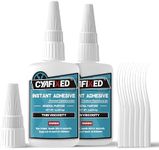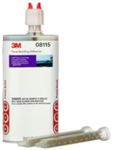Buying Guide for the Best Glue For Plastics
Choosing the right glue for plastics can make a big difference in how strong and long-lasting your repair or project will be. Plastics come in many types, and not all glues work well with every kind. It's important to understand what you need the glue to do—whether it's for a quick fix, a strong bond, or something that will be exposed to water or heat. By learning about the key features of glues for plastics, you can make a choice that matches your project and ensures a reliable result.Type of Plastic CompatibilityNot all glues work with every type of plastic. Some plastics, like polyethylene and polypropylene, are especially hard to bond. Glues are often labeled with the types of plastics they work with, such as ABS, PVC, or acrylic. It's important to check this because using the wrong glue can result in a weak bond or no bond at all. If you know what kind of plastic you're working with, look for a glue that specifically mentions compatibility with that material. If you're unsure, universal plastic glues are available, but they may not be as strong as those made for specific plastics.
Bond StrengthBond strength refers to how well the glue holds the plastic pieces together once it dries. Some glues create a temporary or light bond, while others are designed for heavy-duty, permanent fixes. Light-duty glues are good for crafts or small repairs, while high-strength glues are better for items that will be handled often or need to support weight. Think about how much stress or movement the glued area will experience and choose a glue with a bond strength that matches your needs.
Drying and Curing TimeDrying time is how quickly the glue sets, while curing time is how long it takes to reach full strength. Some glues set in seconds, which is great for quick fixes, but may not allow for repositioning. Others take longer, giving you time to adjust the pieces before the bond becomes permanent. If you need to use or move the item soon after gluing, look for a fast-drying option. For the strongest bond, be patient and allow the full curing time recommended by the manufacturer.
Water and Heat ResistanceIf your glued plastic will be exposed to water, humidity, or high temperatures, it's important to choose a glue that can handle these conditions. Some glues lose their strength or break down when wet or hot. Check the label for water resistance or heat resistance if your project will be used outdoors, in the kitchen, or in other challenging environments. Pick a glue with the right resistance for where and how the item will be used.
Application MethodGlues for plastics come in different forms, such as liquids, gels, or two-part epoxies. Liquids are good for small, tight-fitting surfaces, while gels are less likely to drip and are easier to control on vertical surfaces. Two-part epoxies require mixing and are usually stronger, but take more effort to use. Consider the size and shape of the area you need to glue, and choose a form that will be easy to apply and give you the best results for your project.
Transparency and FinishSome glues dry clear, while others may leave a visible residue or finish. If appearance matters—such as for visible repairs or crafts—look for a glue that dries clear or matches the color of your plastic. For hidden repairs, this may not be as important. Think about whether the glued area will be seen and choose a glue that will look good once it dries.

















